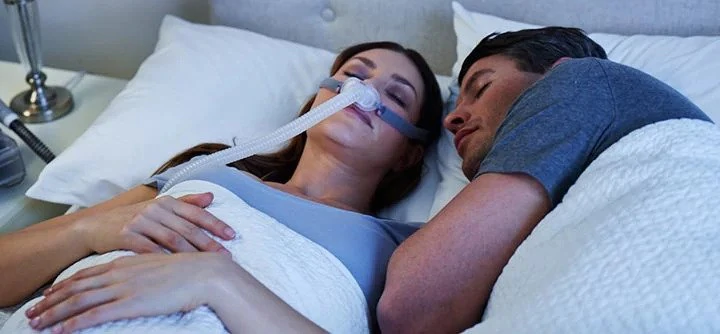Topics: Sleep Apnea, Insomnia
Insomnia and sleep apnea are both sleep disorder, but they affect individuals differently. Insomnia involves difficulty in falling or staying asleep, leading to daytime fatigue and weak functioning. Sleep apnea, on the other hand, is recognized by pauses in breathing during sleep, sometime happens with snoring and frequent awakening.
A good night’s sleep is more important than most people realize. In the era of high-stress work, binge watching sessions, and obsessive reliance on coffee to keep us going, sleep disorders are very common. And two of the most prevalent ones are sleep apnea and insomnia.
While most of us have a basic concept of what insomnia is, understanding of sleep apnea is not very common. Even among those who know, insomnia and sleep apnea are perceived to be very similar.
So let’s take a look at how insomnia and sleep apnea differ in terms of causes, symptoms, and treatment options.
What Causes Insomnia
According to the Academy of Sleep Science, insomnia is the “repeated difficulty with sleep initiation, duration, consolidation, or quality that occurs despite adequate opportunity and circumstances for sleep, and results in some form of daytime impairment.” Essentially, it’s the inability to fall and stay asleep through the night, despite having the right conditions for sleep.
It is a broad category of sleep disorder that can stem from both physical and psychological causes. Hormonal imbalance, stress, anxiety and menopause can all lead to insomnia. On the physical front, consumption of nicotine, excessive caffeine and alcohol, and certain over-the-counter drugs are primary causes.
What Causes Sleep Apnea
On the other hand, sleep apnea refers to repeatedly waking up from your sleep due to lack of oxygen flow to the brain.
With sleep apnea, the causes are entirely physical. In case of obstructive sleep apnea, a part of the soft palate collapses when you sleep, blocking the airflow. That causes the brain to send a signal that tells your body to wake up. Central sleep apnea is when your brain cannot effectively control the muscles in your air passage, thus leading to interrupted airflow.
Symptoms of Sleep Apnea and Insomnia
Both insomnia and sleep apnea lead to diminished quality of sleep and have a bunch of common symptoms. Especially the aftermath of not having a good night’s sleep are the same for both disorders - feeling drowsy or tired throughout the day, headaches etc.
Besides that, the most visible symptoms of insomnia are difficulty falling asleep at night, waking up during the night or waking up too early.
Sleep apnea is characterised by loud snoring, choking or gasping in your sleep, and resultant depression and issues with weight gain.
Treatment Options of Sleep Apnea and Insomnia
An effective treatment for insomnia is cognitive behavioral therapy. It helps people recognise beliefs and behaviours that affect their ability to sleep, and systematically eliminate those. This can involve:
- Reducing factors that cause your mind to resist sleep, and setting up consistent sleep habits.
- Ensuring that you associate the bed and bedroom with sleep and no other activity, like watching TV or work.
- Reducing anxiety before bedtime with muscle relaxation techniques, breathing exercises and biofeedback.
There are other insomnia treatment options like sleep restriction to exhaust your body into falling asleep the next night. And light therapy to train your body clock to natural sleep and wake times.
In cases of severe insomnia, where behavioural therapy doesn’t prove effective, patients can also be prescribed medication. However, these are often in low doses and for short duration, and self-medication or use of over-the-counter drugs can cause more harm than help.
For moderate sleep apnea, the treatment options take a similar course with a focus on changing lifestyle elements. This could mean:
- Losing weight, which can relieve swollen tissues and hence reduce airway blockage during sleep.
- Lowering tobacco consumption, as it can help reduce inflammation and fluid retention in the upper airway, allowing for easier breathing.
- Reducing alcohol consumption, and hence prevent excessive relaxation of your throat muscles that cause airway obstruction.
- Changing your sleep habits. For some people, sleep apnea is present only when sleeping on their back, and learning to sleep on their side can help reduce or eliminate airway blockage.

Besides these, Continuous positive airway pressure (CPAP) devices are a great option for people with obstructive sleep apnea (OSA). These devices can increase the flow of air pressure in the throat, preventing the airway from collapsing when you breathe.
Both sleep apnea and insomnia are recognised sleep disorders that can severely impact your quality of life. However, they are both distinctly different challenges, with different treatment courses. Understanding and correctly identifying whether you experience sleep apnea and insomnia, or both, could be the first step towards reclaiming a good night’s sleep.
And if you feel sleep apnea to be your primary challenge, you can take our Home Sleep Test and consult with a sleep coach at 1800 - 103 - 3969, to know your next steps.




